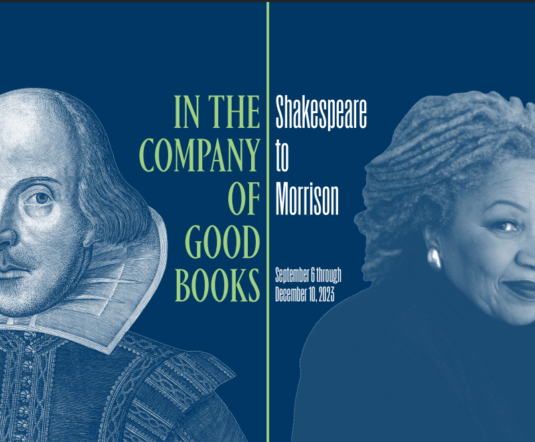 Keep company with literary luminaries this fall! The Department of Special Collections at Princeton University Library invites you to “In the Company of Good Books: Shakespeare to Morrison,” currently on display in the Milberg Gallery of Firestone Library through December 10th.
Keep company with literary luminaries this fall! The Department of Special Collections at Princeton University Library invites you to “In the Company of Good Books: Shakespeare to Morrison,” currently on display in the Milberg Gallery of Firestone Library through December 10th.
In honor of the 400th anniversary of William Shakespeare’s First Folio of 1623, the exhibit showcases Princeton’s collection of English literature, and the readers and writers who celebrated English literature around the world. Curators Jennifer Garcon, Librarian for Modern and Contemporary Special Collections, Gabriel Swift, Librarian for American Collections, and Eric White, Scheide Librarian & Assistant University Librarian for Special Collections, Rare Books & Manuscripts, have selected some true treasures.
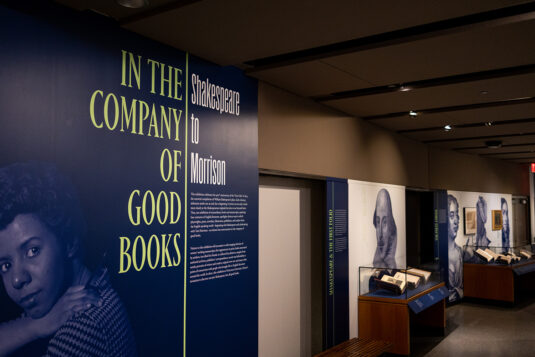
In addition to William Shakespeare and Toni Morrison, you will find Maya Angelou, Sylvia Beach, George Lamming, James Baldwin, Gwendolyn Brooks, Carlos Bolusan, Lorraine Hansberry, Chinua Achebe, Virginia Woolf, and others! Visitors can peruse working manuscripts, archives, original cover art, portraits, and charming inscriptions, including James Baldwin’s personal copy of Maya Angelou’s I Know Why The Caged Bird Sings, signed by the author.
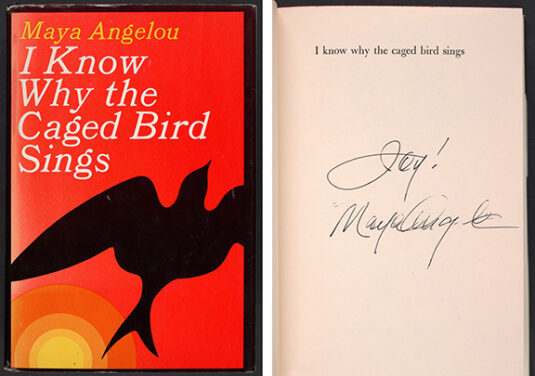
Maya Angelou (1928–2014). I Know Why the Caged Bird Sings. New York: Random House, 1969.
We at the Cotsen Children’s Library are always on the lookout for children’s literary connections, and we found a couple amazing ones in this exhibit! First is one of three tiny manuscripts by Charlotte Bronte. Written when she was a youth, these juvenalia concern the fictional African kingdom of Angria, and are penned on pages bound with blue Epsom salt wrappers. To give you an idea of size, and how minuscule Bronte’s handwriting is, the bound volume on the left is only about 3.5″ tall!
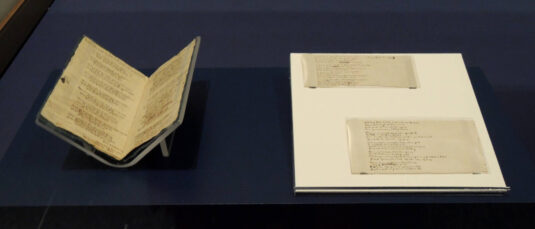 Also in the exhibit are the manuscript notes, sketchbooks, and original storage case of Maria Edgeworth, a prolific novelist for both adults and young readers.
Also in the exhibit are the manuscript notes, sketchbooks, and original storage case of Maria Edgeworth, a prolific novelist for both adults and young readers.
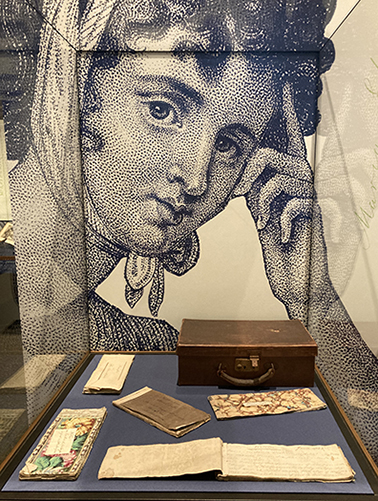 An early edition of Jane Austen’s Sense and Sensibility is displayed, which reminded me of this very interesting fact. When she was only twelve or thirteen, Austen penned The Beautifull Cassandra: A Novel in Twelve Chapters, a tiny work of 465 words total. The Princeton University Press offers a delightful version, with an afterword by Princeton faculty Claudia L. Johnson and artwork by Leon Steinmetz.
An early edition of Jane Austen’s Sense and Sensibility is displayed, which reminded me of this very interesting fact. When she was only twelve or thirteen, Austen penned The Beautifull Cassandra: A Novel in Twelve Chapters, a tiny work of 465 words total. The Princeton University Press offers a delightful version, with an afterword by Princeton faculty Claudia L. Johnson and artwork by Leon Steinmetz.
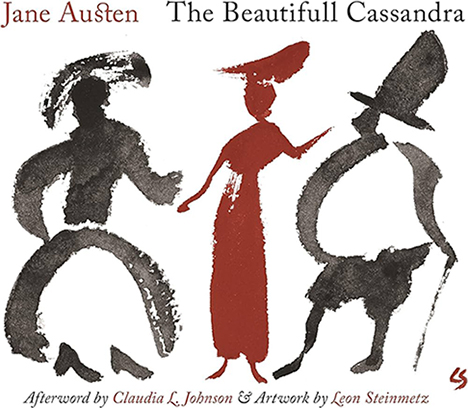 Readers might not be aware that Morrison made significant contributions to children’s literature as well. Collaborating with Slade Morrison, mother and son authored nine books for children. These delightful tales were displayed in Cotsen’s previous exhibit, “They’ve Got Game: The Children’s Books of Toni & Slade Morrison.”
Readers might not be aware that Morrison made significant contributions to children’s literature as well. Collaborating with Slade Morrison, mother and son authored nine books for children. These delightful tales were displayed in Cotsen’s previous exhibit, “They’ve Got Game: The Children’s Books of Toni & Slade Morrison.”
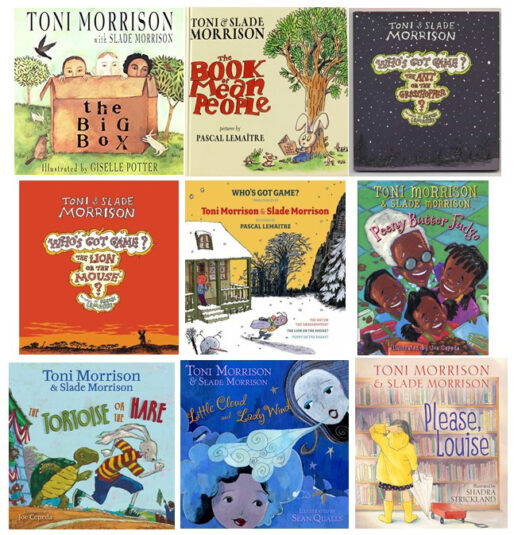 If you are interested in learning more about the exhibit, you will find a digital companion here, and a fantastic Zoom panel with the book’s illustrators here. We also hosted a connected community gallery event this spring, which you can find here.
If you are interested in learning more about the exhibit, you will find a digital companion here, and a fantastic Zoom panel with the book’s illustrators here. We also hosted a connected community gallery event this spring, which you can find here.
From now to December 10th, please plan to visit “In the Company of Good Books” in Princeton! It is truly monumental. Not able to visit in person? No problem! Virtual guests can find the exhibit here.

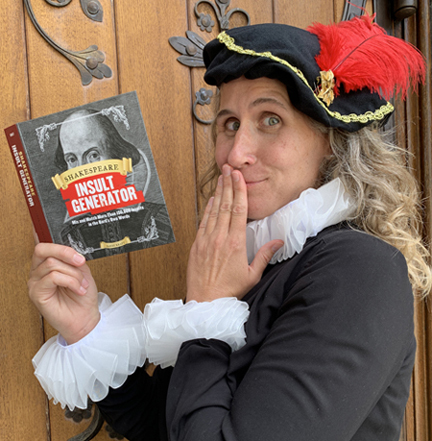 Prepare to “Insult, exult, and all at once” (As You Like It, Act 3, Scene 5). Because today we’re reviewing the epic Shakespeare Insult Generator from Becker & Mayer! Wither you stub your toe on a rock, or are trading barbs with your bitter rival…if your situation requires a fiery oath or stinging retort, you are in good hands with the Bard!
Prepare to “Insult, exult, and all at once” (As You Like It, Act 3, Scene 5). Because today we’re reviewing the epic Shakespeare Insult Generator from Becker & Mayer! Wither you stub your toe on a rock, or are trading barbs with your bitter rival…if your situation requires a fiery oath or stinging retort, you are in good hands with the Bard!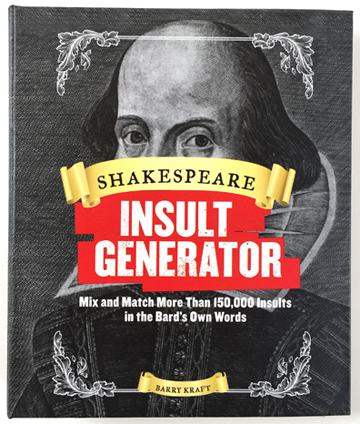 Retailing for around $9 on Amazon, this little spiral-bound volumes includes 162 Shakespearean words. The pages are divided into three sections (the top and middle sections are adjectives, the bottom section is a noun). The sections can be quickly flipped to create 150,000 original insults.
Retailing for around $9 on Amazon, this little spiral-bound volumes includes 162 Shakespearean words. The pages are divided into three sections (the top and middle sections are adjectives, the bottom section is a noun). The sections can be quickly flipped to create 150,000 original insults.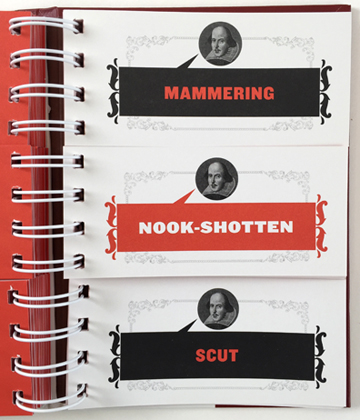 The cool thing is when you flip each section, the word is defined on the back. So if you are wondering what a “scut” is, it’s actually “the short, erect tail of a deer.”
The cool thing is when you flip each section, the word is defined on the back. So if you are wondering what a “scut” is, it’s actually “the short, erect tail of a deer.”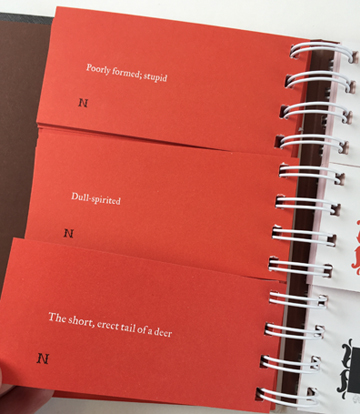 In addition to being visually pleasing, the book comes with a fascinating and humorous introduction. Among other things, you learn that words marked with a feather icon means they were most likely invented by Shakespeare. Words marked with an “N” are ones he only used once (also referred to as “nonce” words). As you can see in the above photo, all three words are nonce. Amazingly, of the 162 words in the book, 22% were invented by Shakespeare, and 64% are nonce! That’s some amazing word-smithery, that is.
In addition to being visually pleasing, the book comes with a fascinating and humorous introduction. Among other things, you learn that words marked with a feather icon means they were most likely invented by Shakespeare. Words marked with an “N” are ones he only used once (also referred to as “nonce” words). As you can see in the above photo, all three words are nonce. Amazingly, of the 162 words in the book, 22% were invented by Shakespeare, and 64% are nonce! That’s some amazing word-smithery, that is.